


- Autor:
- Mark Lutz
- Ocena:
- Bądź pierwszym, który oceni tę książkę
- Stron:
- 1600
- Dostępne formaty:
-
ePubMobi
 opcje wysyłki »
opcje wysyłki »
Opis
książki
:
Programming Python. 3rd Edition
Already the industry standard for Python users, ProgrammingPython fromO'Reilly just got even better. This third edition has been updated toreflect current best practices andthe abundance of changes introduced by the latest version of thelanguage, Python 2.5.
Whether you're a novice or an advancedpractitioner, you'll find thisrefreshed book more than lives up to its reputation. ProgrammingPython, 3rd Edition, teaches you the rightway to code. It explains Python language syntax and programmingtechniques in a clear and concisemanner, with numerous examples that illustrate both correct usage andcommon idioms. By reading thiscomprehensive guide, you'll learn how to apply Python in real-worldproblem domains such as:
- GUI programming
- Internet scripting
- Parallel processing
- Database management
- Networked applications
Programming Python, Third Edition coverseach of thesetarget domainsgradually, beginning with in-depth discussions of core concepts andthen progressing toward completeprograms. Large examples do appear, but only after you've learnedenough to understand their techniques andcode.
Along the way, you'll also learn how to use the Python language inrealistically scaled programs--concepts such as Object-Oriented Programming (OOP) and code reuseare recurring side themes throughout thistext. If you're interested in Python programming, then this O'Reillyclassic needs to be within arm's reach. Thewealth of practical advice, snippets of code, and patterns of programdesign can all be put into use on adaily basis--making your life easier and more productive.
Reviews of the second edition:
"...about as comprehensive as any book can be."
--Dr. Dobb's Journal
"If the language had manuals, they would undoubtedlybe the texts from O'Reilly...'Learning Python' and 'Programming Python'are definitive treatments."
--SD Times
Wybrane bestsellery
-
Nowość Promocja
 Dzięki tej książce pewnie wkroczysz do fascynującego świata internetu rzeczy! Zaczniesz od podstaw: poznasz usługi internetowe, komunikację LoRa, porty GPIO, a także możliwości najnowszych mikrokontrolerów Raspberry Pi. Dowiesz się też, czym jest ROS i jak stworzyć projekt oparty na rozpoznawaniu obrazów. Krok po kroku będziesz przechodzić do coraz bardziej zaawansowanych rozwiązań. Nauczysz się integrować aplikacje z usługami sieciowymi i używać technologii LoRa do komunikacji na dużą odległość przy niskim zużyciu energii. Dzięki jasnym instrukcjom i zrozumiałym wyjaśnieniom uzyskasz niezbędne umiejętności, by tworzyć innowacyjne urządzenia IoT.
Dzięki tej książce pewnie wkroczysz do fascynującego świata internetu rzeczy! Zaczniesz od podstaw: poznasz usługi internetowe, komunikację LoRa, porty GPIO, a także możliwości najnowszych mikrokontrolerów Raspberry Pi. Dowiesz się też, czym jest ROS i jak stworzyć projekt oparty na rozpoznawaniu obrazów. Krok po kroku będziesz przechodzić do coraz bardziej zaawansowanych rozwiązań. Nauczysz się integrować aplikacje z usługami sieciowymi i używać technologii LoRa do komunikacji na dużą odległość przy niskim zużyciu energii. Dzięki jasnym instrukcjom i zrozumiałym wyjaśnieniom uzyskasz niezbędne umiejętności, by tworzyć innowacyjne urządzenia IoT.- PDF + ePub + Mobi
- Druk 69 pkt
(69,50 zł najniższa cena z 30 dni)
69.50 zł
139.00 zł (-50%) -
Nowość Promocja
 W czasach, gdy wiele naszych działań przeniosło się do przestrzeni cyfrowej, tworzymy i agregujemy ogromne ilości danych. Przechowujemy je na dyskach urządzeń, mobilnych nośnikach pamięci, w chmurach, a nawet w formie załączników poczty elektronicznej. Aby uzyskać z nich jak najwięcej informacji, musimy wykonywać odpowiednie procesy analityczno-agregujące, które następnie pozwolą nam na wyciągnięcie właściwych wniosków, a potem podjęcie odpowiednich decyzji. W tym miejscu często pojawia się problem: w jaki sposób pogodzić różne formaty danych, odpowiednio je ze sobą połączyć, wykonać mapowanie i konwertowanie?
W czasach, gdy wiele naszych działań przeniosło się do przestrzeni cyfrowej, tworzymy i agregujemy ogromne ilości danych. Przechowujemy je na dyskach urządzeń, mobilnych nośnikach pamięci, w chmurach, a nawet w formie załączników poczty elektronicznej. Aby uzyskać z nich jak najwięcej informacji, musimy wykonywać odpowiednie procesy analityczno-agregujące, które następnie pozwolą nam na wyciągnięcie właściwych wniosków, a potem podjęcie odpowiednich decyzji. W tym miejscu często pojawia się problem: w jaki sposób pogodzić różne formaty danych, odpowiednio je ze sobą połączyć, wykonać mapowanie i konwertowanie?- PDF + ePub + Mobi
- Druk 29 pkt
(29,49 zł najniższa cena z 30 dni)
29.49 zł
59.00 zł (-50%) -
Promocja
 Stuck in a coding conundrum? Whether you're an advanced beginner, an intermediate developer, or a curious newcomer, the complexities of coding can often feel like a labyrinth with no exit. With Python, however, you can start writing real code quickly—but where should you start? In this updated third edition, Bill Lubanovic acts as your personal gu
Stuck in a coding conundrum? Whether you're an advanced beginner, an intermediate developer, or a curious newcomer, the complexities of coding can often feel like a labyrinth with no exit. With Python, however, you can start writing real code quickly—but where should you start? In this updated third edition, Bill Lubanovic acts as your personal gu-
- ePub + Mobi 143 pkt
(29,90 zł najniższa cena z 30 dni)
143.65 zł
169.00 zł (-15%) -
-
Promocja
 Ta książka jest zwięzłym wprowadzeniem do głównych zagadnień i aspektów uczenia przez wzmacnianie i algorytmów DQL. Docenią ją zarówno naukowcy, jak i praktycy poszukujący skutecznych algorytmów, przydatnych w pracy z finansami. Znajdziesz tu wiele interesujących przykładów w języku Python, zaprezentowanych w formie najciekawszych algorytmów gotowych do samodzielnego modyfikowania i testowania.
Ta książka jest zwięzłym wprowadzeniem do głównych zagadnień i aspektów uczenia przez wzmacnianie i algorytmów DQL. Docenią ją zarówno naukowcy, jak i praktycy poszukujący skutecznych algorytmów, przydatnych w pracy z finansami. Znajdziesz tu wiele interesujących przykładów w języku Python, zaprezentowanych w formie najciekawszych algorytmów gotowych do samodzielnego modyfikowania i testowania.- PDF + ePub + Mobi
- Druk 39 pkt
(39,50 zł najniższa cena z 30 dni)
39.50 zł
79.00 zł (-50%) -
Promocja
 To trzecie, zaktualizowane i uzupełnione wydanie lubianego podręcznika programowania w Pythonie. Zawiera dodatkowe rozdziały dotyczące tak ważnych zagadnień jak algorytmy i struktury danych. Zawarty w książce materiał, w tym słowniki , ułatwi Ci tworzenie solidnego i wydajnego kodu. Znajdziesz tu jasne, zwięzłe i praktyczne rady przeznaczone dla programistów na różnym poziomie zaawansowania. Niezależnie od tego, czy tworzysz aplikacje internetowe, analizujesz dane, czy trenujesz modele sztucznej inteligencji, dzięki temu podręcznikowi zdobędziesz cenne umiejętności pracy z Pythonem!
To trzecie, zaktualizowane i uzupełnione wydanie lubianego podręcznika programowania w Pythonie. Zawiera dodatkowe rozdziały dotyczące tak ważnych zagadnień jak algorytmy i struktury danych. Zawarty w książce materiał, w tym słowniki , ułatwi Ci tworzenie solidnego i wydajnego kodu. Znajdziesz tu jasne, zwięzłe i praktyczne rady przeznaczone dla programistów na różnym poziomie zaawansowania. Niezależnie od tego, czy tworzysz aplikacje internetowe, analizujesz dane, czy trenujesz modele sztucznej inteligencji, dzięki temu podręcznikowi zdobędziesz cenne umiejętności pracy z Pythonem!- PDF + ePub + Mobi
- Druk 69 pkt
(69,50 zł najniższa cena z 30 dni)
69.50 zł
139.00 zł (-50%) -
Promocja
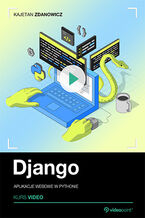 Chcesz wejść do świata IT i szybko zobaczyć efekty swojej nauki? Postaw na framework Django, który pozwala budować nowoczesne, bezpieczne i skalowalne aplikacje webowe. Dzięki przejrzystej strukturze i ogromnej liczbie gotowych komponentów Django idealnie nadaje się dla początkujących, ale spełnia też oczekiwania profesjonalistów. Nie bez powodu korzystali z niego tacy giganci jak Instagram czy nawet NASA – to narzędzie, które sprawdza się nawet przy najbardziej wymagających projektach. Firmy potrzebują osób, które potrafią szybko zbudować i rozwijać aplikacje, by reagować na potrzeby rynku. Znajomość Django to także krok w stronę wyższych stanowisk i lepszych stawek. Wielu senior developerów zaczynało właśnie od tego frameworka. Jeśli marzysz o awansie, niezależności i projektach, które robią różnicę, zacznij od Django i buduj swoją przyszłość już teraz.
Chcesz wejść do świata IT i szybko zobaczyć efekty swojej nauki? Postaw na framework Django, który pozwala budować nowoczesne, bezpieczne i skalowalne aplikacje webowe. Dzięki przejrzystej strukturze i ogromnej liczbie gotowych komponentów Django idealnie nadaje się dla początkujących, ale spełnia też oczekiwania profesjonalistów. Nie bez powodu korzystali z niego tacy giganci jak Instagram czy nawet NASA – to narzędzie, które sprawdza się nawet przy najbardziej wymagających projektach. Firmy potrzebują osób, które potrafią szybko zbudować i rozwijać aplikacje, by reagować na potrzeby rynku. Znajomość Django to także krok w stronę wyższych stanowisk i lepszych stawek. Wielu senior developerów zaczynało właśnie od tego frameworka. Jeśli marzysz o awansie, niezależności i projektach, które robią różnicę, zacznij od Django i buduj swoją przyszłość już teraz.- Videokurs 83 pkt
(39,90 zł najniższa cena z 30 dni)
83.30 zł
119.00 zł (-30%) -
Promocja
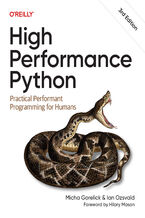 Your Python code may run correctly, but what if you need it to run faster? This practical book shows you how to locate performance bottlenecks and significantly speed up your code in high-data-volume programs. By explaining the fundamental theory behind design choices, this expanded edition of High Performance Python helps experienced Python progra
Your Python code may run correctly, but what if you need it to run faster? This practical book shows you how to locate performance bottlenecks and significantly speed up your code in high-data-volume programs. By explaining the fundamental theory behind design choices, this expanded edition of High Performance Python helps experienced Python progra-
- ePub + Mobi 186 pkt
(29,90 zł najniższa cena z 30 dni)
186.15 zł
219.00 zł (-15%) -
-
Promocja
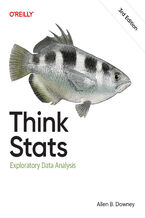 If you know how to program, you have the skills to turn data into knowledge. This thoroughly revised edition presents statistical concepts computationally, rather than mathematically, using programs written in Python. Through practical examples and exercises based on real-world datasets, you'll learn the entire process of exploratory data analysis—
If you know how to program, you have the skills to turn data into knowledge. This thoroughly revised edition presents statistical concepts computationally, rather than mathematically, using programs written in Python. Through practical examples and exercises based on real-world datasets, you'll learn the entire process of exploratory data analysis—-
- ePub + Mobi 228 pkt
(29,90 zł najniższa cena z 30 dni)
228.65 zł
269.00 zł (-15%) -
-
Promocja
 Inteligencja obliczeniowa w machine learning (ML) to zbiór zaawansowanych technik, za sprawą których komputery mogą rozwiązywać złożone problemy, ucząc się z danych, zamiast polegać na regułach programowania. Dzięki algorytmom genetycznym, inspirowanym naturalną ewolucją, można optymalizować procesy w różnych branżach – od inżynierii, przez biotechnologię, aż po logistykę – bez potrzeby tworzenia dużych baz danych. Algorytmy te pozwalają na rozwiązywanie problemów takich jak dopasowywanie parametrów w symulacjach czy optymalizacja tras, co ma szerokie zastosowanie w codziennych wyzwaniach biznesowych.
Inteligencja obliczeniowa w machine learning (ML) to zbiór zaawansowanych technik, za sprawą których komputery mogą rozwiązywać złożone problemy, ucząc się z danych, zamiast polegać na regułach programowania. Dzięki algorytmom genetycznym, inspirowanym naturalną ewolucją, można optymalizować procesy w różnych branżach – od inżynierii, przez biotechnologię, aż po logistykę – bez potrzeby tworzenia dużych baz danych. Algorytmy te pozwalają na rozwiązywanie problemów takich jak dopasowywanie parametrów w symulacjach czy optymalizacja tras, co ma szerokie zastosowanie w codziennych wyzwaniach biznesowych.- Videokurs 209 pkt
(39,90 zł najniższa cena z 30 dni)
209.30 zł
299.00 zł (-30%) -
Promocja
 Na szczęście dzięki tej książce poradzisz sobie z takimi wyzwaniami! Najpierw zapoznasz się z matematycznymi podstawami algorytmów ML i NLP. Zaznajomisz się również z ogólnymi technikami uczenia maszynowego i dowiesz się, w jakim stopniu dotyczą one dużych modeli językowych. Kolejnym zagadnieniem będzie przetwarzanie danych tekstowych, w tym metody przygotowywania tekstu do analizy, po czym przyswoisz zasady klasyfikowania tekstu. Ponadto poznasz zaawansowane aspekty teorii, projektowania i stosowania LLM, wreszcie ― przyszłe trendy w NLP. Aby zdobyć praktyczne umiejętności, będziesz ćwiczyć na przykładach rzeczywistych zagadnień biznesowych i rozwiązań NLP.
Na szczęście dzięki tej książce poradzisz sobie z takimi wyzwaniami! Najpierw zapoznasz się z matematycznymi podstawami algorytmów ML i NLP. Zaznajomisz się również z ogólnymi technikami uczenia maszynowego i dowiesz się, w jakim stopniu dotyczą one dużych modeli językowych. Kolejnym zagadnieniem będzie przetwarzanie danych tekstowych, w tym metody przygotowywania tekstu do analizy, po czym przyswoisz zasady klasyfikowania tekstu. Ponadto poznasz zaawansowane aspekty teorii, projektowania i stosowania LLM, wreszcie ― przyszłe trendy w NLP. Aby zdobyć praktyczne umiejętności, będziesz ćwiczyć na przykładach rzeczywistych zagadnień biznesowych i rozwiązań NLP.- PDF + ePub + Mobi
- Druk 44 pkt
(44,50 zł najniższa cena z 30 dni)
44.50 zł
89.00 zł (-50%)
O autorze książki
Mark Lutz — to znany na całym świecie instruktor Pythona, autor najwcześniejszych oraz najlepiej sprzedających się tekstów poświęconych temu językowi i jedna z najważniejszych postaci w środowisku Pythona. Poza poprzednimi wydaniami tej książki — w tym przetłumaczonej na język polski wersji „Python. Wprowadzenie” (Helion, 2002), napisał także „Programming Python” oraz „Python Pocket Reference”. Osobiście używa języka Python i promuje go od 1992 roku. Książki na temat tego języka zaczął publikować w 1995 roku, zaś szkolenia z Pythona prowadzi od 1997 roku. Do początku roku 2008 przeprowadził ponad dwieście sesji treningowych poświęconych temu językowi.
Mark Lutz - pozostałe książki
-
Nowość Promocja
 Ta książka stanowi kompleksowe i obszerne wprowadzenie do języka Python. Pomoże Ci opanować jego podstawy i przygotuje do praktycznego zastosowania nabytej wiedzy. To wydanie zostało zaktualizowane i rozszerzone, aby odzwierciedlić zmiany zachodzące w świecie Pythona. Pominięto omówienie nieaktualnej wersji 2.X,opisano nowe narzędzia, dodane do Pythona w wersji 3.12, a także innych jego edycji, które są dziś szeroko używane.
Ta książka stanowi kompleksowe i obszerne wprowadzenie do języka Python. Pomoże Ci opanować jego podstawy i przygotuje do praktycznego zastosowania nabytej wiedzy. To wydanie zostało zaktualizowane i rozszerzone, aby odzwierciedlić zmiany zachodzące w świecie Pythona. Pominięto omówienie nieaktualnej wersji 2.X,opisano nowe narzędzia, dodane do Pythona w wersji 3.12, a także innych jego edycji, które są dziś szeroko używane.- PDF + ePub + Mobi
- Druk 99 pkt
(99,50 zł najniższa cena z 30 dni)
99.50 zł
199.00 zł (-50%) -
Promocja
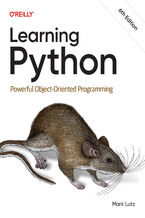 Get a comprehensive, in-depth introduction to the core Python language with this hands-on book. Based on author Mark Lutz's popular training course, this updated sixth edition will help you quickly write efficient, high-quality code with Python. It's an ideal way to begin, whether you're new to programming or a professional developer versed in othe
Get a comprehensive, in-depth introduction to the core Python language with this hands-on book. Based on author Mark Lutz's popular training course, this updated sixth edition will help you quickly write efficient, high-quality code with Python. It's an ideal way to begin, whether you're new to programming or a professional developer versed in othe-
- ePub + Mobi 228 pkt
(29,90 zł najniższa cena z 30 dni)
228.65 zł
269.00 zł (-15%) -
-
Promocja
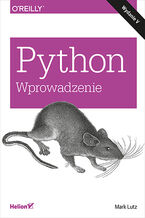 To kompleksowy podręcznik do nauki programowania w Pythonie. Jego piąte wydanie zostało gruntownie zaktualizowane i rozbudowane o dodatkowe treści. Omówiono tu najnowsze wersje Pythona w liniach 3.X i 2.X, czyli 3.3 i 2.7, i dodano opisy nowych lub rozszerzonych mechanizmów, takich jak obsługa formatu JSON, moduł timeit, pakiet PyPy, metoda os.popen, generatory, rekurencje, słabe referencje, atrybuty i metody __mro__, __iter__, super, __slots__, metaklasy, deskryptory, funkcja random, pakiet Sphinx i wiele innych. W książce znalazło się mnóstwo ćwiczeń, quizów, pomocnych ilustracji oraz przykładów kodu. Jest to kompendium dla każdego, kto chce szybko zacząć programować w Pythonie i tworzyć wydajny kod o wysokiej jakości.
To kompleksowy podręcznik do nauki programowania w Pythonie. Jego piąte wydanie zostało gruntownie zaktualizowane i rozbudowane o dodatkowe treści. Omówiono tu najnowsze wersje Pythona w liniach 3.X i 2.X, czyli 3.3 i 2.7, i dodano opisy nowych lub rozszerzonych mechanizmów, takich jak obsługa formatu JSON, moduł timeit, pakiet PyPy, metoda os.popen, generatory, rekurencje, słabe referencje, atrybuty i metody __mro__, __iter__, super, __slots__, metaklasy, deskryptory, funkcja random, pakiet Sphinx i wiele innych. W książce znalazło się mnóstwo ćwiczeń, quizów, pomocnych ilustracji oraz przykładów kodu. Jest to kompendium dla każdego, kto chce szybko zacząć programować w Pythonie i tworzyć wydajny kod o wysokiej jakości.- PDF + ePub + Mobi
- Druk 99 pkt
(99,50 zł najniższa cena z 30 dni)
99.50 zł
199.00 zł (-50%) -
Promocja
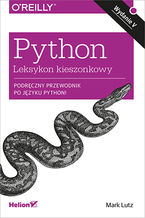 Jeżeli jednak chcesz mieć zawsze pod ręką sprawdzone źródło informacji, które pozwoli Ci w każdej sytuacji rozwiać wątpliwości, to trafiłeś na doskonałą pozycję. Należy ona do serii Leksykon kieszonkowy i charakteryzuje się niezwykle zwięzłym, przejrzystym układem najważniejszych treści oraz poręczną formą. Znajdziesz tu szczegółowe informacje na temat typów wbudowanych, wyjątków, programowania obiektowego oraz przetwarzania nazw i reguł zasięgu. Kolejne wydanie tej książki zostało ulepszone i zaktualizowane o mnóstwo nowych informacji, takich jak wykorzystanie Python Launcher w systemie Windows czy formalne reguły dziedziczenia. To doskonałe źródło informacji na temat języka Python!
Jeżeli jednak chcesz mieć zawsze pod ręką sprawdzone źródło informacji, które pozwoli Ci w każdej sytuacji rozwiać wątpliwości, to trafiłeś na doskonałą pozycję. Należy ona do serii Leksykon kieszonkowy i charakteryzuje się niezwykle zwięzłym, przejrzystym układem najważniejszych treści oraz poręczną formą. Znajdziesz tu szczegółowe informacje na temat typów wbudowanych, wyjątków, programowania obiektowego oraz przetwarzania nazw i reguł zasięgu. Kolejne wydanie tej książki zostało ulepszone i zaktualizowane o mnóstwo nowych informacji, takich jak wykorzystanie Python Launcher w systemie Windows czy formalne reguły dziedziczenia. To doskonałe źródło informacji na temat języka Python!- PDF + ePub + Mobi
- Druk 29 pkt
(29,49 zł najniższa cena z 30 dni)
29.49 zł
59.00 zł (-50%) -
Promocja
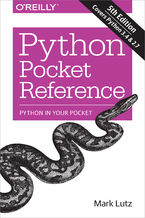 Updated for both Python 3.4 and 2.7, this convenient pocket guide is the perfect on-the-job quick reference. You’ll find concise, need-to-know information on Python types and statements, special method names, built-in functions and exceptions, commonly used standard library modules, and other prominent Python tools. The handy index lets you pinpoin
Updated for both Python 3.4 and 2.7, this convenient pocket guide is the perfect on-the-job quick reference. You’ll find concise, need-to-know information on Python types and statements, special method names, built-in functions and exceptions, commonly used standard library modules, and other prominent Python tools. The handy index lets you pinpoin-
- ePub + Mobi 42 pkt
(29,90 zł najniższa cena z 30 dni)
42.42 zł
49.90 zł (-15%) -
-
Promocja
 Niniejsza książka należy do popularnej serii Leksykon kieszonkowy, dzięki której zawsze i wszędzie możesz przypomnieć sobie wybrane zagadnienia, związane z różną tematyką. Pozycja, którą właśnie trzymasz w rękach, została poświęcona językowi Python. W trakcie jej lektury zapoznasz się z takimi zagadnieniami, jak sterowanie przepływem programu, wykorzystanie pętli, list, słowników oraz operacje na plikach. Ponadto w każdej chwili będziesz mógł sprawdzić składnię oraz sposoby wykorzystania funkcji i wyjątków wbudowanych. Książka stanowi znakomite kompendium wiedzy na temat języka Python. Sprawdzi się ona w rękach początkującego użytkownika - jako przewodnik, a w rękach zaawansowanego programisty - jako pomocnik.
Niniejsza książka należy do popularnej serii Leksykon kieszonkowy, dzięki której zawsze i wszędzie możesz przypomnieć sobie wybrane zagadnienia, związane z różną tematyką. Pozycja, którą właśnie trzymasz w rękach, została poświęcona językowi Python. W trakcie jej lektury zapoznasz się z takimi zagadnieniami, jak sterowanie przepływem programu, wykorzystanie pętli, list, słowników oraz operacje na plikach. Ponadto w każdej chwili będziesz mógł sprawdzić składnię oraz sposoby wykorzystania funkcji i wyjątków wbudowanych. Książka stanowi znakomite kompendium wiedzy na temat języka Python. Sprawdzi się ona w rękach początkującego użytkownika - jako przewodnik, a w rękach zaawansowanego programisty - jako pomocnik.- PDF + ePub + Mobi
- Druk 14 pkt
(14,95 zł najniższa cena z 30 dni)
14.95 zł
29.90 zł (-50%) -
Promocja
 Dzięki tej książce zapoznasz się z podstawowymi typami wbudowanymi Pythona, takimi jak liczby, listy oraz słowniki, nauczysz się tworzyć i przetwarzać obiekty za pomocą instrukcji Pythona, a także opanujesz ogólny model składni tego języka, stworzysz strukturę kodu i wykorzystasz kod ponownie dzięki podstawowym narzędziom proceduralnym Pythona, dowiesz się wszystkiego o modułach Pythona - pakietach instrukcji i funkcji oraz innych narzędziach zorganizowanych w większe komponenty, odkryjesz narzędzie programowania zorientowanego obiektowo, umożliwiające strukturyzację kodu, opanujesz model obsługi wyjątków i narzędzia programistyczne służące do pisania większych programów, zapoznasz się z zaawansowanymi narzędziami Pythona, w tym dekoratorami, deskryptorami, metaklasami i przetwarzaniem tekstu Unicode.
Dzięki tej książce zapoznasz się z podstawowymi typami wbudowanymi Pythona, takimi jak liczby, listy oraz słowniki, nauczysz się tworzyć i przetwarzać obiekty za pomocą instrukcji Pythona, a także opanujesz ogólny model składni tego języka, stworzysz strukturę kodu i wykorzystasz kod ponownie dzięki podstawowym narzędziom proceduralnym Pythona, dowiesz się wszystkiego o modułach Pythona - pakietach instrukcji i funkcji oraz innych narzędziach zorganizowanych w większe komponenty, odkryjesz narzędzie programowania zorientowanego obiektowo, umożliwiające strukturyzację kodu, opanujesz model obsługi wyjątków i narzędzia programistyczne służące do pisania większych programów, zapoznasz się z zaawansowanymi narzędziami Pythona, w tym dekoratorami, deskryptorami, metaklasami i przetwarzaniem tekstu Unicode.- PDF + ePub + Mobi
- Druk 74 pkt
(74,50 zł najniższa cena z 30 dni)
74.50 zł
149.00 zł (-50%) -
Promocja
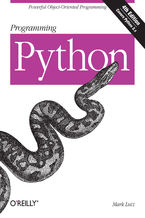 If you've mastered Python's fundamentals, you're ready to start using it to get real work done. Programming Python will show you how, with in-depth tutorials on the language's primary application domains: system administration, GUIs, and the Web. You'll also explore how Python is used in databases, networking, front-end scripting layers, text proce
If you've mastered Python's fundamentals, you're ready to start using it to get real work done. Programming Python will show you how, with in-depth tutorials on the language's primary application domains: system administration, GUIs, and the Web. You'll also explore how Python is used in databases, networking, front-end scripting layers, text proce-
- ePub + Mobi 211 pkt
(29,90 zł najniższa cena z 30 dni)
211.65 zł
249.00 zł (-15%) -
Ebooka "Programming Python. 3rd Edition" przeczytasz na:
-
czytnikach Inkbook, Kindle, Pocketbook, Onyx Boox i innych
-
systemach Windows, MacOS i innych
-
systemach Windows, Android, iOS, HarmonyOS
-
na dowolnych urządzeniach i aplikacjach obsługujących formaty: PDF, EPub, Mobi
Masz pytania? Zajrzyj do zakładki Pomoc »
Szczegóły książki
- ISBN Ebooka:
- 978-05-965-5461-3, 9780596554613
- Data wydania ebooka :
-
2006-08-23
 Data wydania ebooka często jest dniem wprowadzenia tytułu do sprzedaży i może nie być równoznaczna
z datą wydania książki papierowej. Dodatkowe informacje możesz znaleźć w darmowym fragmencie.
Jeśli masz wątpliwości skontaktuj się z nami sklep@ebookpoint.pl.
Data wydania ebooka często jest dniem wprowadzenia tytułu do sprzedaży i może nie być równoznaczna
z datą wydania książki papierowej. Dodatkowe informacje możesz znaleźć w darmowym fragmencie.
Jeśli masz wątpliwości skontaktuj się z nami sklep@ebookpoint.pl.
- Język publikacji:
- angielski
- Rozmiar pliku ePub:
- 10.8MB
- Rozmiar pliku Mobi:
- 24.2MB
Dostępność produktu
Produkt nie został jeszcze oceniony pod kątem ułatwień dostępu lub nie podano żadnych informacji o ułatwieniach dostępu lub są one niewystarczające. Prawdopodobnie Wydawca/Dostawca jeszcze nie umożliwił dokonania walidacji produktu lub nie przekazał odpowiednich informacji na temat jego dostępności.
Spis treści książki
- Programming Python, 3rd Edition
- A Note Regarding Supplemental Files
- Foreword
- How Time Flies!
- Coming Attractions
- Concluding Remarks
- Foreword to the Second Edition (2001)
- Foreword from the First Edition (1996)
- Preface
- And Now for Something Completely Different . . . Again
- About This Book
- About This Edition
- Python Changes
- Example Changes
- Topic Changes
- Focus Unchanged
- This Books Motivation
- This Books Structure
- This Editions Design
- Its Been Updated for Python 2.4 (and 2.5)
- Its Been Reorganized
- It Covers New Topics
- Its Still Mostly Platform-Neutral
- C integration code platform issues
- Its Still Focused for a More Advanced Audience
- Its Still Example-Oriented
- Using the Books Examples
- The Book Examples Tree
- The Book Examples Distribution Package
- Running Examples: The Short Story
- Running Examples: The Details
- Demos and gadgets
- Setup requirements
- Web-based examples
- Top-level programs
- Conventions Used in This Book
- Safari Enabled
- Where to Look for Updates
- Contacting OReilly
- Using Code Examples
- Acknowledgments
- I. The Beginning
- 1. Introducing Python
- 1.1. And Now for Something Completely Different
- 1.2. Python Philosophy 101
- 1.3. The Life of Python
- 1.4. Signs of the Python Times
- 1.4.1. Recent Growth (As of 2005, at Least)
- 1.5. The Compulsory Features List
- 1.6. Whats Python Good For?
- 1.7. Whats Python Not Good For?
- 1.8. Truth in Advertising
- 2. A Sneak Preview
- 2.1. Programming Python: The Short Story
- 2.2. The Task
- 2.3. Step 1: Representing Records
- 2.3.1. Using Lists
- 2.3.1.1. A database list
- 2.3.1.2. Field labels
- 2.3.2. Using Dictionaries
- 2.3.2.1. Other ways to make dictionaries
- 2.3.2.2. Lists of dictionaries
- 2.3.2.3. Nested structures
- 2.3.2.4. Dictionaries of dictionaries
- 2.3.1. Using Lists
- 2.4. Step 2: Storing Records Persistently
- 2.4.1. Using Formatted Files
- 2.4.1.1. Test data script
- 2.4.1.2. Data format script
- 2.4.1.3. Utility scripts
- 2.4.2. Using Pickle Files
- 2.4.3. Using Per-Record Pickle Files
- 2.4.4. Using Shelves
- 2.4.1. Using Formatted Files
- 2.5. Step 3: Stepping Up to OOP
- 2.5.1. Using Classes
- 2.5.2. Adding Behavior
- 2.5.3. Adding Inheritance
- 2.5.4. Refactoring Code
- 2.5.4.1. Augmenting methods
- 2.5.4.2. Display format
- 2.5.4.3. Constructor customization
- 2.5.4.4. Alternative classes
- 2.5.5. Adding Persistence
- 2.5.6. Other Database Options
- 2.6. Step 4: Adding Console Interaction
- 2.6.1. A Console Shelve Interface
- 2.7. Step 5: Adding a GUI
- 2.7.1. GUI Basics
- 2.7.2. Using OOP for GUIs
- 2.7.3. Getting Input from a User
- 2.7.4. A GUI Shelve Interface
- 2.7.4.1. Coding the GUI
- 2.7.4.2. Using the GUI
- 2.7.4.3. Future directions
- 2.8. Step 6: Adding a Web Interface
- 2.8.1. CGI Basics
- 2.8.2. Running a Web Server
- 2.8.3. Using Query Strings and urllib
- 2.8.4. Formatting Reply Text
- 2.8.5. A Web-Based Shelve Interface
- 2.8.5.1. Coding the web site
- 2.8.5.2. Using the web site
- 2.8.5.3. Future directions
- 2.9. The End of the Demo
- 1. Introducing Python
- II. System Programming
- 3. System Tools
- 3.1. The os.path to Knowledge
- 3.1.1. Why Python Here?
- 3.1.2. The Next Five Chapters
- 3.2. System Scripting Overview
- 3.2.1. Python System Modules
- 3.2.2. Module Documentation Sources
- 3.2.3. Paging Documentation Strings
- 3.2.4. Introducing String Methods
- 3.2.5. File Operation Basics
- 3.2.6. Using Programs in Two Ways
- 3.2.7. Python Library Manuals
- 3.2.8. Commercially Published References
- 3.3. Introducing the sys Module
- 3.3.1. Platforms and Versions
- 3.3.2. The Module Search Path
- 3.3.3. The Loaded Modules Table
- 3.3.4. Exception Details
- 3.3.5. Other sys Module Exports
- 3.4. Introducing the os Module
- 3.4.1. The Big os Lists
- 3.4.2. Administrative Tools
- 3.4.3. Portability Constants
- 3.4.4. Basic os.path Tools
- 3.4.5. Running Shell Commands from Scripts
- 3.4.5.1. Whats a shell command?
- 3.4.5.2. Running shell commands
- 3.4.5.3. Communicating with shell commands
- 3.4.5.4. Shell command limitations
- 3.4.6. Other os Module Exports
- 3.5. Script Execution Context
- 3.6. Current Working Directory
- 3.6.1. CWD, Files, and Import Paths
- 3.6.2. CWD and Command Lines
- 3.7. Command-Line Arguments
- 3.8. Shell Environment Variables
- 3.8.1. Fetching Shell Variables
- 3.8.2. Changing Shell Variables
- 3.8.3. Shell Variable Details
- 3.9. Standard Streams
- 3.9.1. Redirecting Streams to Files and Programs
- 3.9.1.1. Redirecting streams to files
- 3.9.1.2. Chaining programs with pipes
- 3.9.1.3. Coding alternatives
- 3.9.1.4. Redirected streams and user interaction
- 3.9.1.5. Reading keyboard input
- 3.9.2. Redirecting Streams to Python Objects
- 3.9.3. The StringIO Module
- 3.9.4. Capturing the stderr Stream
- 3.9.5. Redirection Syntax in Print Statements
- 3.9.6. Other Redirection Options
- 3.9.1. Redirecting Streams to Files and Programs
- 3.1. The os.path to Knowledge
- 4. File and Directory Tools
- 4.1. Erase Your Hard Drive in Five Easy Steps!
- 4.2. File Tools
- 4.2.1. Built-In File Objects
- 4.2.1.1. Output files
- 4.2.1.1.1. Opening
- 4.2.1.1.2. Writing
- 4.2.1.1.3. Closing
- 4.2.1.2. Input files
- 4.2.1.3. Reading lines with file iterators
- 4.2.1.4. Other file object modes
- 4.2.1.5. Binary datafiles
- 4.2.1.6. End-of-line translations on Windows
- 4.2.1.7. Parsing packed binary data with the struct module
- 4.2.1.1. Output files
- 4.2.2. File Tools in the os Module
- 4.2.2.1. Open mode flags
- 4.2.2.2. Other os file tools
- 4.2.3. File Scanners
- 4.2.1. Built-In File Objects
- 4.3. Directory Tools
- 4.3.1. Walking One Directory
- 4.3.1.1. Running shell listing commands with os.popen
- 4.3.1.2. The glob module
- 4.3.1.3. The os.listdir call
- 4.3.1.4. Splitting and joining listing results
- 4.3.2. Walking Directory Trees
- 4.3.2.1. The os.path.walk visitor
- 4.3.2.2. The os.walk generator
- 4.3.2.3. Recursive os.listdir traversals
- 4.3.3. Rolling Your Own find Module
- 4.3.1. Walking One Directory
- 5. Parallel System Tools
- 5.1. Telling the Monkeys What to Do
- 5.2. Forking Processes
- 5.2.1. The fork/exec Combination
- 5.2.1.1. os.exec call formats
- 5.2.1.2. Spawned child program
- 5.2.1. The fork/exec Combination
- 5.3. Threads
- 5.3.1. The thread Module
- 5.3.1.1. Synchronizing access to global objects
- 5.3.1.2. Waiting for spawned thread exits
- 5.3.2. The threading Module
- 5.3.3. The Queue Module
- 5.3.4. The Global Interpreter Lock and Threads
- 5.3.4.1. The thread switch interval
- 5.3.4.2. Atomic operations
- 5.3.4.3. C API thread considerations
- 5.3.1. The thread Module
- 5.4. Program Exits
- 5.4.1. os Module Exits
- 5.4.2. Exit Status Codes
- 5.4.3. Process Exit Status
- 5.4.4. Thread Exits
- 5.5. Interprocess Communication
- 5.6. Pipes
- 5.6.1. Anonymous Pipe Basics
- 5.6.2. Bidirectional IPC with Pipes
- 5.6.2.1. Deadlocks, flushes, and unbuffered streams
- 5.6.3. Named Pipes (Fifos)
- 5.7. Signals
- 5.8. Other Ways to Start Programs
- 5.8.1. The os.spawn Calls
- 5.8.2. Launching Programs on Windows
- 5.8.2.1. Using the DOS start command
- 5.8.2.2. Using start in Python scripts
- 5.8.2.3. The os.startfile call
- 5.8.3. Other Program Launch Options
- 5.9. A Portable Program-Launch Framework
- 5.10. Other System Tools
- 6. System Examples: Utilities
- 6.1. Splits and Joins and Alien Invasions
- 6.2. Splitting and Joining Files
- 6.2.1. Splitting Files Portably
- 6.2.1.1. Operation modes
- 6.2.1.2. Binary file access
- 6.2.1.3. Manually closing files
- 6.2.2. Joining Files Portably
- 6.2.2.1. Reading by blocks or files
- 6.2.2.2. Sorting filenames
- 6.2.3. Usage Variations
- 6.2.1. Splitting Files Portably
- 6.3. Generating Forward-Link Web Pages
- 6.3.1. Page Template File
- 6.3.2. Page Generator Script
- 6.4. A Regression Test Script
- 6.5. Packing and Unpacking Files
- 6.5.1. Packing Files ++
- 6.5.2. Application Hierarchy Superclasses
- 6.5.2.1. StreamApp: adding stream redirection
- 6.5.2.2. App: the root class
- 6.5.2.3. Why use classes here?
- 6.6. Automated Program Launchers
- 6.6.1. Launcher Module Clients
- 6.6.2. Launching Programs Without Environment Settings
- 6.6.3. Launching Web Browsers Portably
- 6.6.3.1. Launching browsers with command lines
- 6.6.3.2. Launching browsers with function calls
- 6.6.3.3. Viewing multimedia in browsers
- 6.6.4. A Portable Media File Player Tool
- 6.6.4.1. The Python webbrowser module
- 6.6.4.2. The Python mimetypes module
- 7. System Examples: Directories
- 7.1. The Greps of Wrath
- 7.2. Fixing DOS Line Ends
- 7.2.1. Converting Line Ends in One File
- 7.2.1.1. Slinging bytes and verifying results
- 7.2.1.2. Nonintrusive conversions
- 7.2.1.3. Slicing strings out of bounds
- 7.2.1.4. Binary file mode revisited
- 7.2.2. Converting Line Ends in One Directory
- 7.2.3. Converting Line Ends in an Entire Tree
- 7.2.3.1. The view from the top
- 7.2.1. Converting Line Ends in One File
- 7.3. Fixing DOS Filenames
- 7.3.1. Rewriting with os.path.walk
- 7.4. Searching Directory Trees
- 7.4.1. Greps and Globs in Shells and Python
- 7.4.1.1. Cleaning up bytecode files
- 7.4.2. A Python Tree Searcher
- 7.4.1. Greps and Globs in Shells and Python
- 7.5. Visitor: Walking Trees Generically
- 7.5.1. Editing Files in Directory Trees
- 7.5.2. Global Replacements in Directory Trees
- 7.5.3. Collecting Matched Files in Trees
- 7.5.3.1. Suppressing status messages
- 7.5.4. Recoding Fixers with Visitors
- 7.5.5. Fixing File Permissions in Trees
- 7.5.6. Changing Unix Executable Path Lines
- 7.5.7. Summary: Counting Source Lines Four Ways
- 7.6. Copying Directory Trees
- 7.6.1. A Python Tree Copy Script
- 7.6.2. Recoding Copies with a Visitor-Based Class
- 7.7. Deleting Directory Trees
- 7.7.1. Recoding Deletions for Generality
- 7.8. Comparing Directory Trees
- 7.8.1. Finding Directory Differences
- 7.8.2. Finding Tree Differences
- 7.8.3. Running the Script
- 7.8.3.1. Verifying CD backups
- 7.8.4. Reporting Differences
- 3. System Tools
- III. GUI Programming
- 8. Graphical User Interfaces
- 8.1. Heres Looking at You, Kid
- 8.1.1. GUI Programming Topics
- 8.2. Python GUI Development Options
- 8.3. Tkinter Overview
- 8.3.1. Tkinter Pragmatics
- 8.3.2. Tkinter Documentation
- 8.3.3. Tkinter Extensions
- 8.3.4. Tkinter Structure
- 8.4. Climbing the GUI Learning Curve
- 8.4.1. Hello World in Four Lines (or Less)
- 8.5. Tkinter Coding Basics
- 8.5.1. Making Widgets
- 8.5.2. Geometry Managers
- 8.5.3. Running GUI Programs
- 8.5.3.1. Avoiding DOS consoles on Windows
- 8.6. Tkinter Coding Alternatives
- 8.6.1. Widget Resizing Basics
- 8.6.2. Configuring Widget Options and Window Titles
- 8.6.3. One More for Old Times Sake
- 8.6.4. Packing Widgets Without Saving Them
- 8.7. Adding Buttons and Callbacks
- 8.7.1. Widget Resizing Revisited: Expansion
- 8.8. Adding User-Defined Callback Handlers
- 8.8.1. Lambda Callback Handlers
- 8.8.1.1. Passing in values with default arguments
- 8.8.1.2. Passing in values with enclosing scope references
- 8.8.1.3. Enclosing scopes versus defaults
- 8.8.2. Bound Method Callback Handlers
- 8.8.3. Callable Class Object Callback Handlers
- 8.8.4. Other Tkinter Callback Protocols
- 8.8.5. Binding Events
- 8.8.1. Lambda Callback Handlers
- 8.9. Adding Multiple Widgets
- 8.9.1. Widget Resizing Revisited: Clipping
- 8.9.2. Attaching Widgets to Frames
- 8.9.3. Layout: Packing Order and Side Attachments
- 8.9.4. The Packers Expand and Fill Revisited
- 8.9.5. Using Anchor to Position Instead of Stretch
- 8.10. Customizing Widgets with Classes
- 8.11. Reusable GUI Components with Classes
- 8.11.1. Attaching Class Components
- 8.11.2. Extending Class Components
- 8.11.3. Standalone Container Classes
- 8.12. The End of the Tutorial
- 8.13. Python/Tkinter for Tcl/Tk Converts
- 8.1. Heres Looking at You, Kid
- 9. A Tkinter Tour, Part 1
- 9.1. Widgets and Gadgets and GUIs, Oh My!
- 9.1.1. This Chapters Topics
- 9.2. Configuring Widget Appearance
- 9.3. Top-Level Windows
- 9.3.1. Toplevel and Tk Widgets
- 9.3.2. Top-Level Window Protocols
- 9.4. Dialogs
- 9.4.1. Standard (Common) Dialogs
- 9.4.1.1. A smart and reusable Quit button
- 9.4.1.2. A dialog demo launcher bar
- 9.4.1.3. Printing dialog results (and passing callback data with lambdas)
- 9.4.1.4. Letting users select colors on the fly
- 9.4.1.5. Other standard dialog calls
- 9.4.2. The Old-Style Dialog Module
- 9.4.3. Custom Dialogs
- 9.4.3.1. Making custom dialogs modal
- 9.4.3.2. Other ways to be modal
- 9.4.1. Standard (Common) Dialogs
- 9.5. Binding Events
- 9.6. Message and Entry
- 9.6.1. Message
- 9.6.2. Entry
- 9.6.2.1. Programming Entry widgets
- 9.6.2.2. Laying out input forms
- 9.6.2.3. Going modal again
- 9.6.2.4. Tkinter variables
- 9.7. Checkbutton, Radiobutton, and Scale
- 9.7.1. Checkbuttons
- 9.7.1.1. Check buttons and variables
- 9.7.2. Radio Buttons
- 9.7.2.1. Radio buttons and variables
- 9.7.2.2. Radio buttons without variables
- 9.7.2.3. Hold onto your variables
- 9.7.3. Scales (Sliders)
- 9.7.3.1. Scales and variables
- 9.7.1. Checkbuttons
- 9.8. Running GUI Code Three Ways
- 9.8.1. Attaching Frames
- 9.8.2. Independent Windows
- 9.8.3. Running Programs
- 9.8.3.1. Cross-program communication
- 9.8.3.2. Coding for reusability
- 9.9. Images
- 9.9.1. Fun with Buttons and Pictures
- 9.10. Viewing and Processing Images with PIL
- 9.10.1. PIL Basics
- 9.10.2. Displaying Other Image Types with PIL
- 9.10.2.1. Displaying all images in a directory
- 9.10.3. Creating Image Thumbnails with PIL
- 9.10.3.1. Performance: saving thumbnail files
- 9.10.3.2. Layout: gridding and fixed-size widgets
- 9.10.3.3. Scrolling and canvases
- 9.1. Widgets and Gadgets and GUIs, Oh My!
- 10. A Tkinter Tour, Part 2
- 10.1. On Todays Menu: Spam, Spam, and Spam
- 10.2. Menus
- 10.2.1. Top-Level Window Menus
- 10.2.2. Frame- and Menubutton-Based Menus
- 10.2.2.1. Using Menubuttons and Optionmenus
- 10.2.3. Windows with Both Menus and Toolbars
- 10.2.3.1. Automating menu construction
- 10.3. Listboxes and Scrollbars
- 10.3.1. Programming Listboxes
- 10.3.2. Programming Scroll Bars
- 10.3.3. Packing Scroll Bars
- 10.4. Text
- 10.4.1. Programming the Text Widget
- 10.4.1.1. Text is a Python string
- 10.4.1.2. String positions
- 10.4.1.2.1. Text indexes
- 10.4.1.2.2. Text marks
- 10.4.1.2.3. Text tags
- 10.4.2. Adding Text-Editing Operations
- 10.4.2.1. Using the clipboard
- 10.4.2.2. Composition versus inheritance
- 10.4.2.3. Its called Simple for a reason
- 10.4.3. Advanced Text and Tag Operations
- 10.4.1. Programming the Text Widget
- 10.5. Canvas
- 10.5.1. Basic Canvas Operations
- 10.5.2. Programming the Canvas Widget
- 10.5.2.1. Coordinates
- 10.5.2.2. Object construction
- 10.5.2.3. Object identifiers and operations
- 10.5.2.4. Canvas object tags
- 10.5.3. Scrolling Canvases
- 10.5.4. Scrollable Canvases and Image Thumbnails
- 10.5.4.1. Scrolling images too: PyPhoto (ahead)
- 10.5.5. Using Canvas Events
- 10.5.5.1. Binding events on specific items
- 10.6. Grids
- 10.6.1. Grid Basics
- 10.6.2. grid Versus pack
- 10.6.3. Combining grid and pack
- 10.6.4. Making Gridded Widgets Expandable
- 10.6.4.1. Resizing in grids
- 10.6.4.2. Spanning columns and rows
- 10.6.5. Laying Out Larger Tables with grid
- 10.7. Time Tools, Threads, and Animation
- 10.7.1. Using Threads with GUIs
- 10.7.2. Using the after Method
- 10.7.2.1. Hiding and redrawing widgets and windows
- 10.7.3. Simple Animation Techniques
- 10.7.3.1. Using time.sleep loops
- 10.7.3.2. Using widget.after events
- 10.7.3.3. Using multiple time.sleep loop threads
- 10.7.4. Other Animation Concepts: Threads and Toolkits
- 10.8. The End of the Tour
- 10.9. The PyDemos and PyGadgets Launchers
- 10.9.1. PyDemos Launcher Bar
- 10.9.2. PyGadgets Launcher Bar
- 11. GUI Coding Techniques
- 11.1. Building a Better Mouse Trap
- 11.2. GuiMixin: Common Tool Mixin Classes
- 11.3. GuiMaker: Automating Menus and Toolbars
- 11.3.1. Subclass Protocols
- 11.3.2. GuiMaker Classes
- 11.3.3. GuiMaker Self-Test
- 11.3.4. BigGui: A Client Demo Program
- 11.4. ShellGui: GUIs for Command-Line Tools
- 11.4.1. A Generic Shell-Tools Display
- 11.4.2. Application-Specific Tool Set Classes
- 11.4.3. Adding GUI Frontends to Command Lines
- 11.5. GuiStreams: Redirecting Streams to Widgets
- 11.5.1. Using Redirection for the Packing Scripts
- 11.6. Reloading Callback Handlers Dynamically
- 11.7. Wrapping Up Top-Level Window Interfaces
- 11.8. GUIs, Threads, and Queues
- 11.8.1. Placing Callbacks on Queues
- 11.9. More Ways to Add GUIs to Non-GUI Code
- 11.9.1. Popping up GUI Windows on Demand
- 11.9.2. Adding a GUI As a Separate Program: Sockets
- 11.9.3. Adding a GUI As a Separate Program: Pipes
- 12. Complete GUI Programs
- 12.1. Python, Open Source, and Camaros
- 12.1.1. Examples in Other Chapters
- 12.1.2. This Chapters Strategy
- 12.2. PyEdit: A Text Editor Program/Object
- 12.2.1. Running PyEdit
- 12.2.1.1. Menus and toolbars
- 12.2.1.2. Dialogs
- 12.2.1.3. Running program code
- 12.2.1.4. New features in version 2.0
- 12.2.2. PyEdit Source Code
- 12.2.1. Running PyEdit
- 12.3. PyPhoto: An Image Viewer and Resizer
- 12.3.1. Running PyPhoto
- 12.3.2. PyPhoto Source Code
- 12.4. PyView: An Image and Notes Slideshow
- 12.4.1. Running PyView
- 12.4.2. PyView Source Code
- 12.5. PyDraw: Painting and Moving Graphics
- 12.5.1. Running PyDraw
- 12.5.2. PyDraw Source Code
- 12.6. PyClock: An Analog/Digital Clock Widget
- 12.6.1. A Quick Geometry Lesson
- 12.6.2. Running PyClock
- 12.6.3. PyClock Source Code
- 12.7. PyToe: A Tic-Tac-Toe Game Widget
- 12.7.1. Running PyToe
- 12.7.2. PyToe Source Code (Book Examples Distribution)
- 12.8. Where to Go from Here
- 12.1. Python, Open Source, and Camaros
- 8. Graphical User Interfaces
- IV. Internet Programming
- 13. Network Scripting
- 13.1. Tune In, Log On, and Drop Out
- 13.1.1. Internet Scripting Topics
- 13.1.1.1. What we will cover
- 13.1.1.2. What we wont cover
- 13.1.1.3. Running examples in this part of the book
- 13.1.1. Internet Scripting Topics
- 13.2. Plumbing the Internet
- 13.2.1. The Socket Layer
- 13.2.1.1. Machine identifiers
- 13.2.2. The Protocol Layer
- 13.2.2.1. Port number rules
- 13.2.2.2. Clients and servers
- 13.2.2.3. Protocol structures
- 13.2.3. Pythons Internet Library Modules
- 13.2.1. The Socket Layer
- 13.3. Socket Programming
- 13.3.1. Socket Basics
- 13.3.1.1. Server socket calls
- 13.3.1.2. Client socket calls
- 13.3.1.3. Running socket programs locally
- 13.3.1.4. Running socket programs remotely
- 13.3.1.5. Socket pragmatics
- 13.3.1.6. Spawning clients in parallel
- 13.3.1.7. Talking to reserved ports
- 13.3.1. Socket Basics
- 13.4. Handling Multiple Clients
- 13.4.1. Forking Servers
- 13.4.1.1. Running the forking server
- 13.4.1.2. Forking processes
- 13.4.1.3. Exiting from children
- 13.4.1.4. Killing the zombies
- 13.4.1.5. Preventing zombies with signal handlers
- 13.4.2. Threading Servers
- 13.4.3. Standard Library Server Classes
- 13.4.4. Third-Party Server Tools: Twisted
- 13.4.5. Multiplexing Servers with select
- 13.4.5.1. A select-based echo server
- 13.4.5.2. Running the select server
- 13.4.6. Choosing a Server Scheme
- 13.4.1. Forking Servers
- 13.5. A Simple Python File Server
- 13.5.1. Running the File Server and Clients
- 13.5.2. Adding a User-Interface Frontend
- 13.5.2.1. Using Frames and command lines
- 13.5.2.2. Using grids and function calls
- 13.5.2.3. Using a reusable form-layout class
- 13.1. Tune In, Log On, and Drop Out
- 14. Client-Side Scripting
- 14.1. Socket to Me!
- 14.2. FTP: Transferring Files over the Net
- 14.2.1. Fetching Files with ftplib
- 14.2.2. Using urllib to FTP Files
- 14.2.3. FTP get and put Utilities
- 14.2.3.1. Download utility
- 14.2.3.2. Upload utility
- 14.2.3.3. Playing the Monty Python theme song
- 14.2.3.4. Adding user interfaces
- 14.2.4. Downloading Web Sites (Mirrors)
- 14.2.5. Uploading Web Sites
- 14.2.6. Refactoring Uploads and Downloads for Reuse
- 14.2.6.1. Refactoring with functions
- 14.2.6.2. Refactoring with classes
- 14.2.7. Uploads and Deletes with Subdirectories
- 14.2.7.1. Uploading local trees
- 14.2.7.2. Deleting remote trees
- 14.3. Processing Internet Email
- 14.4. POP: Fetching Email
- 14.4.1. Mail Configuration Module
- 14.4.2. POP Mail Reader Script
- 14.4.3. Fetching Messages
- 14.4.4. Fetching Email at the Interactive Prompt
- 14.5. SMTP: Sending Email
- 14.5.1. SMTP Mail Sender Script
- 14.5.2. Sending Messages
- 14.5.3. More Ways to Abuse the Net
- 14.5.4. Back to the Big Internet Picture
- 14.5.5. Sending Email from the Interactive Prompt
- 14.6. email: Parsing and Composing Mails
- 14.6.1. Message Objects
- 14.6.2. Basic email Interfaces in Action
- 14.7. pymail: A Console-Based Email Client
- 14.7.1. Running the pymail Console Client
- 14.8. The mailtools Utility Package
- 14.8.1. Initialization File
- 14.8.2. MailTool Class
- 14.8.3. MailSender Class
- 14.8.4. MailFetcher Class
- 14.8.4.1. General usage
- 14.8.4.2. Inbox synchronization tools
- 14.8.5. MailParser Class
- 14.8.6. Self-Test Script
- 14.8.7. Updating the pymail Console Client
- 14.9. NNTP: Accessing Newsgroups
- 14.10. HTTP: Accessing Web Sites
- 14.11. Module urllib Revisited
- 14.11.1. Other urllib Interfaces
- 14.12. Other Client-Side Scripting Options
- 15. The PyMailGUI Client
- 15.1. Use the Source, Luke
- 15.1.1. Source Code Modules
- 15.1.2. Why PyMailGUI?
- 15.1.3. Running PyMailGUI
- 15.1.4. Presentation Strategy
- 15.1.5. New in This Edition
- 15.2. A PyMailGUI Demo
- 15.2.1. Getting Started
- 15.2.2. Loading Mail
- 15.2.3. Threading Model
- 15.2.4. Load Server Interface
- 15.2.5. Offline Processing with Save and Open
- 15.2.6. Sending Email and Attachments
- 15.2.7. Viewing Email and Attachments
- 15.2.8. Email Replies and Forwards
- 15.2.9. Deleting Email
- 15.2.10. POP Message Numbers and Synchronization
- 15.2.11. Multiple Windows and Status Messages
- 15.3. PyMailGUI Implementation
- 15.3.1. Code Reuse
- 15.3.2. Code Structure
- 15.3.3. PyMailGui2: The Main Module
- 15.3.4. SharedNames: Program-Wide Globals
- 15.3.5. ListWindows: Message List Windows
- 15.3.6. ViewWindows: Message View Windows
- 15.3.7. messagecache: Message Cache Manager
- 15.3.8. popuputil: General-Purpose GUI Pop Ups
- 15.3.9. wraplines: Line Split Tools
- 15.3.10. mailconfig: User Configurations
- 15.3.11. PyMailGuiHelp: User Help Text
- 15.3.12. Ideas for Improvement
- 15.1. Use the Source, Luke
- 16. Server-Side Scripting
- 16.1. Oh What a Tangled Web We Weave
- 16.2. Whats a Server-Side CGI Script?
- 16.2.1. The Script Behind the Curtain
- 16.2.2. Writing CGI Scripts in Python
- 16.3. Running Server-Side Examples
- 16.3.1. Web Server Options
- 16.3.2. Running a Local Web Server
- 16.3.3. The Server-Side Examples Root Page
- 16.3.4. Viewing Server-Side Examples and Output
- 16.4. Climbing the CGI Learning Curve
- 16.4.1. A First Web Page
- 16.4.1.1. HTML basics
- 16.4.1.2. Internet addresses (URLs)
- 16.4.1.3. Using minimal URLs
- 16.4.1.4. HTML file permission constraints
- 16.4.2. A First CGI Script
- 16.4.2.1. Installing CGI scripts
- 16.4.2.2. Finding Python on remote servers
- 16.4.3. Adding Pictures and Generating Tables
- 16.4.3.1. Table tags
- 16.4.4. Adding User Interaction
- 16.4.4.1. Submission page
- 16.4.4.2. More on form tags
- 16.4.4.3. Response script
- 16.4.4.4. Passing parameters in URLs
- 16.4.4.5. Testing outside browsers with the module urllib
- 16.4.5. Using Tables to Lay Out Forms
- 16.4.5.1. Converting strings in CGI scripts
- 16.4.5.2. Debugging CGI scripts
- 16.4.6. Adding Common Input Devices
- 16.4.7. Changing Input Layouts
- 16.4.7.1. Keeping display and logic separate
- 16.4.8. Passing Parameters in Hardcoded URLs
- 16.4.9. Passing Parameters in Hidden Form Fields
- 16.4.1. A First Web Page
- 16.5. Saving State Information in CGI Scripts
- 16.5.1. URL Query Parameters
- 16.5.2. Hidden Form Input Fields
- 16.5.3. HTTP Cookies
- 16.5.3.1. Creating a cookie
- 16.5.3.2. Receiving a cookie
- 16.5.3.3. Using cookies in CGI scripts
- 16.5.3.4. Handling cookies with the module urllib2
- 16.5.4. Server-Side Databases
- 16.5.5. Extensions to the CGI Model
- 16.5.6. Combining Techniques
- 16.6. The Hello World Selector
- 16.6.1. Checking for Missing and Invalid Inputs
- 16.7. Refactoring Code for Maintainability
- 16.7.1. Step 1: Sharing Objects Between PagesA New Input Form
- 16.7.2. Step 2: A Reusable Form Mock-Up Utility
- 16.7.3. Step 3: Putting It All TogetherA New Reply Script
- 16.8. More on HTML and URL Escapes
- 16.8.1. URL Escape Code Conventions
- 16.8.2. Python HTML and URL Escape Tools
- 16.8.3. Escaping HTML Code
- 16.8.4. Escaping URLs
- 16.8.5. Escaping URLs Embedded in HTML Code
- 16.8.5.1. HTML and URL conflicts: &
- 16.8.5.2. Avoiding conflicts
- 16.9. Transferring Files to Clients and Servers
- 16.9.1. Displaying Arbitrary Server Files on the Client
- 16.9.1.1. Handling private files and errors
- 16.9.2. Uploading Client Files to the Server
- 16.9.2.1. Handling client path formats
- 16.9.3. More Than One Way to Push Bits over the Net
- 16.9.1. Displaying Arbitrary Server Files on the Client
- 17. The PyMailCGI Server
- 17.1. Things to Do When Visiting Chicago
- 17.2. The PyMailCGI Web Site
- 17.2.1. Implementation Overview
- 17.2.2. New in This Edition
- 17.2.3. Presentation Overview
- 17.2.4. Running This Chapters Examples
- 17.3. The Root Page
- 17.3.1. Configuring PyMailCGI
- 17.4. Sending Mail by SMTP
- 17.4.1. The Message Composition Page
- 17.4.2. The Send Mail Script
- 17.4.3. Error Pages
- 17.4.4. Common Look-and-Feel
- 17.4.5. Using the Send Mail Script Outside a Browser
- 17.5. Reading POP Email
- 17.5.1. The POP Password Page
- 17.5.2. The Mail Selection List Page
- 17.5.3. Passing State Information in URL Link Parameters
- 17.5.4. Security Protocols
- 17.5.4.1. Reading mail with direct URLs
- 17.5.5. The Message View Page
- 17.5.6. Passing State Information in HTML Hidden Input Fields
- 17.5.7. Escaping Mail Text and Passwords in HTML
- 17.6. Processing Fetched Mail
- 17.6.1. Reply and Forward
- 17.6.2. Delete
- 17.6.3. Deletions and POP Message Numbers
- 17.6.3.1. Inbox synchronization error potential
- 17.6.3.2. Passing header text in hidden input fields (PyMailCGI_2.1)
- 17.6.3.3. Server-side files for headers
- 17.6.3.4. Delete on load
- 17.7. Utility Modules
- 17.7.1. External Components and Configuration
- 17.7.2. POP Mail Interface
- 17.7.3. POP Password Encryption
- 17.7.3.1. Manual data encryption: rotor (defunct)
- 17.7.3.2. Manual data encryption: PyCrypto
- 17.7.3.3. Secure HTTP transmissions
- 17.7.3.4. Secure cookies
- 17.7.3.5. The secret.py module
- 17.7.3.6. Rolling your own encryptor
- 17.7.4. Common Utilities Module
- 17.8. CGI Script Trade-Offs
- 17.8.1. Other Approaches
- 18. Advanced Internet Topics
- 18.1. Surfing on the Shoulders of Giants
- 18.2. Zope: A Web Application Framework
- 18.2.1. Zope Overview
- 18.2.1.1. Zope hierarchy model
- 18.2.1.2. Zope scripting
- 18.2.1.3. Zope components
- 18.2.2. Zope Object Publishing
- 18.2.3. A Zope External Method
- 18.2.3.1. Calling through the Web
- 18.2.3.2. Calling from other objects
- 18.2.4. A Simple Zope Interactive Web Site
- 18.2.1. Zope Overview
- 18.3. HTMLgen: Web Pages from Objects
- 18.3.1. A Brief HTMLgen Tutorial
- 18.4. Jython: Python for Java
- 18.4.1. A Quick Introduction to Jython
- 18.4.2. Why Jython?
- 18.4.3. A Simple Jython Example
- 18.4.4. Interface Automation Tricks
- 18.4.5. Writing Java Applets in Jython
- 18.4.6. Jython Trade-Offs
- 18.4.7. Picking Your Python
- 18.5. Grail: A Python-Based Web Browser
- 18.5.1. A Simple Grail Applet Example
- 18.6. XML Processing Tools
- 18.6.1. A Brief Introduction to XML Parsing
- 18.7. Windows Web Scripting Extensions
- 18.7.1. Active Scripting: Client-Side Embedding
- 18.7.1.1. Active Scripting basics
- 18.7.1.2. Embedding Python in HTML
- 18.7.2. Active Server Pages: Server-Side Embedding
- 18.7.2.1. A short ASP example
- 18.7.3. The COM Connection
- 18.7.3.1. A brief introduction to COM
- 18.7.3.2. Python COM clients
- 18.7.3.3. Python COM servers
- 18.7.3.3.1. Using the Python server from a Python client
- 18.7.3.3.2. Using the Python server from a Visual Basic client
- 18.7.3.3.3. Using the Python server with client-side Active Scripting
- 18.7.3.4. The bigger COM picture: DCOM
- 18.7.1. Active Scripting: Client-Side Embedding
- 18.8. Python Server Pages
- 18.8.1. PSP in Webware and mod_python
- 18.9. Rolling Your Own Servers in Python
- 18.9.1. Standard Library Socket Servers
- 18.9.2. Standard Library Web Servers
- 18.9.3. Third-Party Solutions
- 18.10. And Other Cool Stuff
- 13. Network Scripting
- V. Tools and Techniques
- 19. Databases and Persistence
- 19.1. Give Me an Order of Persistence, but Hold the Pickles
- 19.2. Persistence Options in Python
- 19.3. DBM Files
- 19.3.1. Using DBM Files
- 19.4. Pickled Objects
- 19.4.1. Using Object Pickling
- 19.4.2. Picking in Action
- 19.4.3. Pickler Protocols and cPickle
- 19.5. Shelve Files
- 19.5.1. Using Shelves
- 19.5.2. Storing Built-In Object Types in Shelves
- 19.5.3. Storing Class Instances in Shelves
- 19.5.4. Changing Classes of Objects Stored in Shelves
- 19.5.5. Shelve Constraints
- 19.5.5.1. Keys must be strings
- 19.5.5.2. Objects are unique only within a key
- 19.5.5.3. Updates must treat shelves as fetch-modify-store mappings
- 19.5.5.4. Concurrent updates are not directly supported
- 19.5.5.5. Underlying DBM format portability
- 19.5.6. Pickled Class Constraints
- 19.5.7. Other Shelve Limitations
- 19.6. The ZODB Object-Oriented Database
- 19.6.1. A ZODB Tutorial
- 19.6.1.1. Installing ZODB
- 19.6.1.2. The ZEO distributed object server
- 19.6.1.3. Creating a ZODB database
- 19.6.1.4. Fetching and changing
- 19.6.2. Using Classes with ZODB
- 19.6.3. A ZODB People Database
- 19.6.4. ZODB Resources
- 19.6.1. A ZODB Tutorial
- 19.7. SQL Database Interfaces
- 19.7.1. SQL Interface Overview
- 19.7.2. An SQL Database API Tutorial
- 19.7.2.1. The MySQL system
- 19.7.2.2. Installation
- 19.7.2.3. Getting started
- 19.7.2.4. Making databases and tables
- 19.7.2.5. Adding records
- 19.7.2.6. Running queries
- 19.7.2.7. Running updates
- 19.7.3. Building Record Dictionaries
- 19.7.3.1. Using table descriptions
- 19.7.3.2. Record dictionaries
- 19.7.3.3. Automating with scripts and modules
- 19.7.4. Tying the Pieces Together
- 19.7.5. Loading Database Tables from Files
- 19.7.5.1. Loading with SQL and Python
- 19.7.5.2. Python versus SQL
- 19.7.6. SQL Utility Scripts
- 19.7.6.1. Table load scripts
- 19.7.6.2. Table display script
- 19.7.6.3. Using the scripts
- 19.7.7. SQL Resources
- 19.8. PyForm: A Persistent Object Viewer
- 19.8.1. Processing Shelves with Code
- 19.8.2. Adding a Graphical Interface
- 19.8.3. PyForm GUI Implementation
- 19.8.4. PyForm Table Wrappers
- 19.8.5. PyForm Creation and View Utility Scripts
- 19.8.5.1. Creating and browsing custom databases
- 19.8.6. Data as Code
- 19.8.7. Browsing Other Kinds of Objects with PyForm
- 19.8.8. Browsing Other Kinds of Databases with PyForm
- 19.8.9. PyForm Limitations
- 20. Data Structures
- 20.1. Roses Are Red, Violets Are Blue; Lists Are Mutable, and So Is Set Foo
- 20.2. Implementing Stacks
- 20.2.1. A Stack Module
- 20.2.2. A Stack Class
- 20.2.3. Customization: Performance Monitors
- 20.2.4. Optimization: Tuple Tree Stacks
- 20.2.5. Optimization: In-Place List Modifications
- 20.2.6. Timing the Improvements
- 20.2.6.1. Results under Python 1.5.2
- 20.2.6.2. Results under Python 2.4
- 20.3. Implementing Sets
- 20.3.1. Set Functions
- 20.3.1.1. Supporting multiple operands
- 20.3.2. Set Classes
- 20.3.3. Optimization: Moving Sets to Dictionaries
- 20.3.3.1. Timing the results under Python 2.4
- 20.3.3.2. Timing results under Python 1.5.2: version skew
- 20.3.3.3. Using the Python profiler
- 20.3.4. Optimizing fastset by Coding Techniques (or Not)
- 20.3.5. Adding Relational Algebra to Sets (External)
- 20.3.1. Set Functions
- 20.4. Subclassing Built-In Types
- 20.5. Binary Search Trees
- 20.6. Graph Searching
- 20.6.1. Moving Graphs to Classes
- 20.7. Reversing Sequences
- 20.8. Permuting Sequences
- 20.9. Sorting Sequences
- 20.9.1. Adding Comparison Functions
- 20.10. Data Structures Versus Python Built-Ins
- 20.11. PyTree: A Generic Tree Object Viewer
- 20.11.1. Running PyTree
- 20.11.2. PyTree Source Code
- 20.11.2.1. Tree-independent GUI implementation
- 20.11.2.2. Tree wrappers and test widgets
- 20.11.3. PyTree Does Parse Trees Too
- 21. Text and Language
- 21.1. See Jack Hack. Hack, Jack, Hack
- 21.2. Strategies for Parsing Text in Python
- 21.3. String Method Utilities
- 21.3.1. Templating with Replacements and Formats
- 21.3.2. Parsing with Splits and Joins
- 21.3.3. Summing Columns in a File
- 21.3.4. Parsing and Unparsing Rule Strings
- 21.3.5. More on the holmes Expert System Shell
- 21.4. Regular Expression Pattern Matching
- 21.4.1. First Examples
- 21.4.2. Using the re Module
- 21.4.2.1. Module functions
- 21.4.2.2. Compiled pattern objects
- 21.4.2.3. Match objects
- 21.4.2.4. Regular expression patterns
- 21.4.3. Basic Patterns
- 21.4.4. Scanning C Header Files for Patterns
- 21.4.5. A File Pattern Search Utility
- 21.5. Advanced Language Tools
- 21.6. Handcoded Parsers
- 21.6.1. The Expression Grammar
- 21.6.2. The Parsers Code
- 21.6.3. Adding a Parse Tree Interpreter
- 21.6.4. Parse Tree Structure
- 21.6.5. Exploring Parse Trees with PyTree
- 21.6.6. Parsers Versus Python
- 21.7. PyCalc: A Calculator Program/Object
- 21.7.1. A Simple Calculator GUI
- 21.7.1.1. Building the GUI
- 21.7.1.2. Running code strings
- 21.7.1.3. Extending and attaching
- 21.7.2. PyCalcA Real Calculator GUI
- 21.7.2.1. Running PyCalc
- 21.7.2.2. Evaluating expressions with stacks
- 21.7.2.3. PyCalc source code
- 21.7.2.4. Using PyCalc as a component
- 21.7.2.5. Adding new buttons in new components
- 21.7.1. A Simple Calculator GUI
- 19. Databases and Persistence
- VI. Integration
- 22. Extending Python
- 22.1. I Am Lost at C
- 22.2. Integration Modes
- 22.2.1. Presentation Notes
- 22.3. C Extensions Overview
- 22.4. A Simple C Extension Module
- 22.5. Extension Module Details
- 22.5.1. Compilation and Linking
- 22.5.1.1. Dynamic binding
- 22.5.1.2. Static binding
- 22.5.1.3. Static versus dynamic binding
- 22.5.2. Compiling with the Distutils System
- 22.5.3. Anatomy of a C Extension Module
- 22.5.4. Data Conversions
- 22.5.4.1. Python to C: using Python argument lists
- 22.5.4.2. Python to C: using Python return values
- 22.5.4.3. C to Python: returning values to Python
- 22.5.4.4. Common conversion codes
- 22.5.5. Error Handling
- 22.5.5.1. Raising Python exceptions in C
- 22.5.5.2. Detecting errors that occur in Python
- 22.5.6. Reference Counts
- 22.5.7. Other Extension Tasks: Threads
- 22.5.1. Compilation and Linking
- 22.6. The SWIG Integration Code Generator
- 22.6.1. A Simple SWIG Example
- 22.6.2. SWIG Details
- 22.7. Wrapping C Environment Calls
- 22.7.1. Adding Wrapper Classes to Flat Libraries
- 22.7.2. But Dont Do That EitherSWIG
- 22.8. A C Extension Module String Stack
- 22.8.1. But Dont Do That EitherSWIG
- 22.9. A C Extension Type String Stack
- 22.9.1. Anatomy of a C Extension Type
- 22.9.2. Compiling and Running
- 22.9.3. Timing the C Implementations
- 22.9.4. Older Timing Results
- 22.9.5. But Dont Do That EitherSWIG
- 22.10. Wrapping C++ Classes with SWIG
- 22.10.1. A Simple C++ Extension Class
- 22.10.2. Wrapping the C++ Class with SWIG
- 22.10.3. Using the C++ Class in Python
- 22.10.3.1. Using the low-level extension module
- 22.10.3.2. Subclassing the C++ class in Python
- 22.10.3.3. Exploring the wrappers interactively
- 22.11. Other Extending Tools
- 23. Embedding Python
- 23.1. Add Python. Mix Well. Repeat.
- 23.2. C Embedding API Overview
- 23.2.1. What Is Embedded Code?
- 23.3. Basic Embedding Techniques
- 23.3.1. Running Simple Code Strings
- 23.3.1.1. Compiling and running
- 23.3.2. Running Code Strings with Results and Namespaces
- 23.3.3. Calling Python Objects
- 23.3.4. Running Strings in Dictionaries
- 23.3.5. Precompiling Strings to Bytecode
- 23.3.1. Running Simple Code Strings
- 23.4. Registering Callback Handler Objects
- 23.5. Using Python Classes in C
- 23.6. A High-Level Embedding API: ppembed
- 23.6.1. Running Objects with ppembed
- 23.6.2. Running Code Strings with ppembed
- 23.6.3. Running Customizable Validations
- 23.6.3.1. Running function-based validations
- 23.6.3.2. Other validation components
- 23.6.4. ppembed Implementation
- 23.6.5. Other Integration Examples (External)
- 23.7. Other Integration Topics
- 23.7.1. Jython: Java Integration
- 23.7.2. IronPython: C#/.NET Integration
- 23.7.3. COM Integration on Windows
- 23.7.4. CORBA Integration
- 23.7.5. Other Languages
- 23.7.6. Network-Based Integration Protocols
- 23.7.7. Integration Versus Optimization
- 23.7.7.1. Framework roles
- 23.7.7.2. Extension module roles
- 23.7.7.3. Picking an integration technology
- 22. Extending Python
- VIII. The End
- 24. Conclusion: Python and the Development Cycle
- 24.1. Thats the End of the Book, Now Heres the Meaning of Life
- 24.2. Somethings Wrong with the Way We Program Computers
- 24.3. The Gilligan Factor
- 24.4. Doing the Right Thing
- 24.4.1. The Static Language Build Cycle
- 24.4.2. Artificial Complexities
- 24.4.3. One Language Does Not Fit All
- 24.5. Enter Python
- 24.6. But What About That Bottleneck?
- 24.6.1. Python Provides Immediate Turnaround
- 24.6.2. Python Is Executable Pseudocode
- 24.6.3. Python Is OOP Done Right
- 24.6.4. Python Fosters Hybrid Applications
- 24.7. On Sinking the Titanic
- 24.8. So Whats Python: The Sequel?
- 24.9. In the Final Analysis . . .
- 24.10. Postscript to the Second Edition (2000)
- 24.10.1. Integration Isnt Everything
- 24.10.2. The End of the Java Wars
- 24.10.3. Were Not Off That Island Yet
- 24.11. Postscript to the Third Edition (2006)
- 24.11.1. Proof of Concept
- 24.11.2. Integration Today
- 24.11.3. Quality Counts
- 24. Conclusion: Python and the Development Cycle
- Index
- Colophon
- Copyright
O'Reilly Media - inne książki
-
Promocja
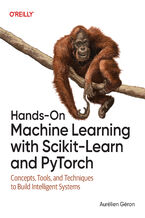 The potential of machine learning today is extraordinary, yet many aspiring developers and tech professionals find themselves daunted by its complexity. Whether you're looking to enhance your skill set and apply machine learning to real-world projects or are simply curious about how AI systems function, this book is your jumping-off place. With an
The potential of machine learning today is extraordinary, yet many aspiring developers and tech professionals find themselves daunted by its complexity. Whether you're looking to enhance your skill set and apply machine learning to real-world projects or are simply curious about how AI systems function, this book is your jumping-off place. With an-
- ePub + Mobi 254 pkt
(245,65 zł najniższa cena z 30 dni)
254.15 zł
299.00 zł (-15%) -
-
Promocja
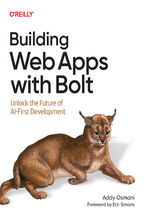 AI-assisted coding and cloud-based tools are already transforming how modern applications are built. Bolt.new, a powerful in-browser AI agent from StackBlitz, streamlines the development process, allowing you to prototype quickly, debug intelligently, and launch confidently—no local setup required. Whether you're new to full stack development or lo
AI-assisted coding and cloud-based tools are already transforming how modern applications are built. Bolt.new, a powerful in-browser AI agent from StackBlitz, streamlines the development process, allowing you to prototype quickly, debug intelligently, and launch confidently—no local setup required. Whether you're new to full stack development or lo-
- ePub + Mobi 169 pkt
(29,90 zł najniższa cena z 30 dni)
169.14 zł
199.00 zł (-15%) -
-
Promocja
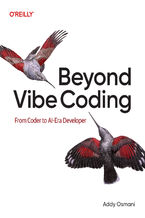 AI is transforming software development, shifting programmers from writing code to collaborating with AI in an intent-driven workflow. Vibe coding—a prompt-first, exploratory approach where you describe what you want in natural language and let a large language model fill in the blanks—represents a radical shift in the developer's role from writing
AI is transforming software development, shifting programmers from writing code to collaborating with AI in an intent-driven workflow. Vibe coding—a prompt-first, exploratory approach where you describe what you want in natural language and let a large language model fill in the blanks—represents a radical shift in the developer's role from writing-
- ePub + Mobi 203 pkt
(29,90 zł najniższa cena z 30 dni)
203.15 zł
239.00 zł (-15%) -
-
Promocja
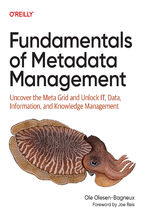 Whether it's to adhere to regulations, access markets by meeting specific standards, or devise data analytics and AI strategies, companies today are busy implementing metadata repositories—metadata tools about the data, information, and knowledge in your company. Until now, most of these repositories have been implemented in isolation from one anot
Whether it's to adhere to regulations, access markets by meeting specific standards, or devise data analytics and AI strategies, companies today are busy implementing metadata repositories—metadata tools about the data, information, and knowledge in your company. Until now, most of these repositories have been implemented in isolation from one anot-
- ePub + Mobi 228 pkt
(29,90 zł najniższa cena z 30 dni)
228.65 zł
269.00 zł (-15%) -
-
Promocja
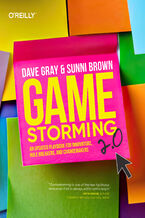 In today's environment of partial attention and isolating remote work, few things are more satisfying than group experiences that produce powerful, meaningful connections and output. But this kind of enlivening, collective work doesn't happen by chance. It must be consciously designed and purposefully activated--;in a team, an organization, and a c
In today's environment of partial attention and isolating remote work, few things are more satisfying than group experiences that produce powerful, meaningful connections and output. But this kind of enlivening, collective work doesn't happen by chance. It must be consciously designed and purposefully activated--;in a team, an organization, and a c-
- ePub + Mobi 143 pkt
(29,90 zł najniższa cena z 30 dni)
143.65 zł
169.00 zł (-15%) -
-
Promocja
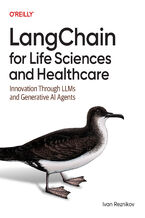 Feeling overwhelmed by the volume of data in your research? Sifting through massive amounts of data to find useful insights is becoming increasingly difficult in drug discovery, genetics, and healthcare. Enter the era of generative AI with LangChain, whose groundbreaking tools are changing the way life scientists and researchers operate. In this g
Feeling overwhelmed by the volume of data in your research? Sifting through massive amounts of data to find useful insights is becoming increasingly difficult in drug discovery, genetics, and healthcare. Enter the era of generative AI with LangChain, whose groundbreaking tools are changing the way life scientists and researchers operate. In this g-
- ePub + Mobi 228 pkt
(29,90 zł najniższa cena z 30 dni)
228.65 zł
269.00 zł (-15%) -
-
Promocja
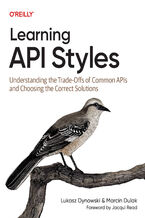 An application programming interface (API) enables data exchange in systems such as web applications, microservices, and IoT devices. In this hands-on book, authors Lukasz Dynowski and Marcin Dulak show software developers and architects how to design and implement REST, GraphQL, gRPC, webhooks, WebSocket, messaging APIs, and more. This book look
An application programming interface (API) enables data exchange in systems such as web applications, microservices, and IoT devices. In this hands-on book, authors Lukasz Dynowski and Marcin Dulak show software developers and architects how to design and implement REST, GraphQL, gRPC, webhooks, WebSocket, messaging APIs, and more. This book look-
- ePub + Mobi 203 pkt
(29,90 zł najniższa cena z 30 dni)
203.15 zł
239.00 zł (-15%) -
-
Promocja
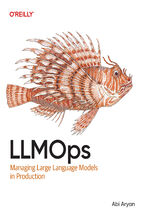 Here's the thing about large language models: they don't play by the old rules. Traditional MLOps completely falls apart when you're dealing with GenAI. The model hallucinates, security assumptions crumble, monitoring breaks, and agents can't operate. Suddenly you're in uncharted territory. That's exactly why LLMOps has emerged as its own disciplin
Here's the thing about large language models: they don't play by the old rules. Traditional MLOps completely falls apart when you're dealing with GenAI. The model hallucinates, security assumptions crumble, monitoring breaks, and agents can't operate. Suddenly you're in uncharted territory. That's exactly why LLMOps has emerged as its own disciplin-
- ePub + Mobi 228 pkt
(29,90 zł najniższa cena z 30 dni)
228.65 zł
269.00 zł (-15%) -
-
Promocja
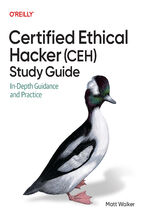 The CEH exam is not an enjoyable undertaking. This grueling, exhaustive, challenging, and taxing exam will either leave you better prepared to be the best cyber security professional you can be. But preparing for the exam itself needn't be that way. In this book, IT security and education professional Matt Walker will not only guide you through ev
The CEH exam is not an enjoyable undertaking. This grueling, exhaustive, challenging, and taxing exam will either leave you better prepared to be the best cyber security professional you can be. But preparing for the exam itself needn't be that way. In this book, IT security and education professional Matt Walker will not only guide you through ev-
- ePub + Mobi 186 pkt
(29,90 zł najniższa cena z 30 dni)
186.15 zł
219.00 zł (-15%) -
-
Promocja
 Eager to learn AI and machine learning but unsure where to start? Laurence Moroney's hands-on, code-first guide demystifies complex AI concepts without relying on advanced mathematics. Designed for programmers, it focuses on practical applications using PyTorch, helping you build real-world models without feeling overwhelmed.From computer vision an
Eager to learn AI and machine learning but unsure where to start? Laurence Moroney's hands-on, code-first guide demystifies complex AI concepts without relying on advanced mathematics. Designed for programmers, it focuses on practical applications using PyTorch, helping you build real-world models without feeling overwhelmed.From computer vision an-
- ePub + Mobi 228 pkt
(29,90 zł najniższa cena z 30 dni)
228.65 zł
269.00 zł (-15%) -
Dzięki opcji "Druk na żądanie" do sprzedaży wracają tytuły Grupy Helion, które cieszyły sie dużym zainteresowaniem, a których nakład został wyprzedany.
Dla naszych Czytelników wydrukowaliśmy dodatkową pulę egzemplarzy w technice druku cyfrowego.
Co powinieneś wiedzieć o usłudze "Druk na żądanie":
- usługa obejmuje tylko widoczną poniżej listę tytułów, którą na bieżąco aktualizujemy;
- cena książki może być wyższa od początkowej ceny detalicznej, co jest spowodowane kosztami druku cyfrowego (wyższymi niż koszty tradycyjnego druku offsetowego). Obowiązująca cena jest zawsze podawana na stronie WWW książki;
- zawartość książki wraz z dodatkami (płyta CD, DVD) odpowiada jej pierwotnemu wydaniu i jest w pełni komplementarna;
- usługa nie obejmuje książek w kolorze.
Masz pytanie o konkretny tytuł? Napisz do nas: sklep@ebookpoint.pl
Książka drukowana


Postaraj się złożyć zamówienie do godziny 13:00, w dniach:
18. grudnia (Poczta Polska),
19. grudnia (Paczka w Ruchu),
22. grudnia (paczkomaty InPost),
22. grudnia (DPD punkty).
22. grudnia (DPD Kurier).







Oceny i opinie klientów: Programming Python. 3rd Edition Mark Lutz
(0)